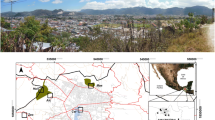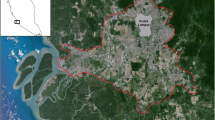Abstract
Few long-term examples exist of wildlife population trends in urban environments despite the recent recognition of the importance of biodiversity in cities. Founded in 1896, Griffith Park’s over 1,700 ha in Los Angeles adjacent to Hollywood represent the largest municipal park in California. Through the 1920s, biologists studied the natural area with great interest but in the decades that followed, little fieldwork was conducted here as Los Angeles developed into a megacity surrounding the park. We combined thorough examination of Griffith Park historical field notes and specimen records (1900–1960) with recent field surveys (2011–2012) to determine (1) the extent of urbanization impacts on butterfly extirpation and persistence and (2) how butterfly traits and host plant relationships might be contributing to butterfly species status. Here we document multiple local butterfly extinctions in Griffith Park; 10 species or 18 % of the historically reconstructed community. Many of these species were lost early in the twentieth century, highlighting the importance of the historical record in understanding urban biodiversity patterns and trends. An analysis of larval host plant status and relationships suggests that a primary factor determining butterfly presence or extirpation is the abundance of the larval host plant in the park, in addition to host plant specificity. Despite these extirpations, we also found that the majority (over 80 %) of native butterfly species have persisted including species of conservation interest. While urban parks certainly suffer from surrounding anthropogenic pressure and impacts, this study also demonstrates the potentially high and underappreciated conservation and ecological value of urban parks.


Similar content being viewed by others
References
Bartoń K (2012) MuMIn: multi-model inference. R package version, 1.9.5. http://CRAN.R-project.org/package=MuMIn
Bergman K-O, Askling J, Ekberg O, Ignell H, Wahlman H, Milberg P (2004) Landscape effects on butterfly assemblages in an agricultural region. Ecography 27:619–628
Blair RB (1999) Birds and butterflies along an urban gradient: surrogate taxa for assessing biodiversity. Ecol Appl 9:164–170
Blair RB, Launer AE (1997) Butterfly diversity and human land use: species assemblages along an urban gradient. Biol Conserv 8:113–125
Bonebrake TC, Sorto R (2009) Butterfly (Papilionoidea and Hesperioidea) rapid assessment of a coastal countryside in El Salvador. Trop Conserv Sci 2:34–51
Bonebrake TC, Christensen J, Boggs CL, Ehrlich PR (2010) Population decline assessment, historical baselines, and conservation. Conserv Lett 3:371–378
Brown KS, Freitas AVL (2002) Butterfly communities of urban forest fragments in Campinas, São Paulo, Brazil: structure, instability, environmental correlates, and conservation. J Insect Conserv 6:217–231
Burnham KP, Anderson DR (2002) Model selection and multi-model inference: a practical information-theoretic approach. Springer, New York
Clark PJ, Reed JM, Chew FS (2007) Effects of urbanization on butterfly species richness, guild structure, and rarity. Urban Ecosyst 10:321–337
Comstock JA (1926) Studies in Pacific Coast Lepidoptera (continued). Thirteen new species or aberrations of California butterflies. Bull South Calif Acad Sci 25:29–34
Comstock JA (1927) Butterflies of California: a popular guide to a knowledge of the butterflies of California. Author, Los Angeles
Connor EF, Hafernik J, Levy J, Moore VL, Rickman JK (2002) Insect conservation in an urban biodiversity hotspot: the San Francisco Bay Area. J Insect Conserv 6:247–259
Cooper DS (2011) Rare plants of Griffith Park, Los Angeles. Fremontia 38:18–24
Cooper DS, Mathewson P (2009) Griffith Park wildlife management plan. Unpublished report. Prepared by Cooper Ecological Monitoring, Inc. for the Los Angeles Dept. of Recreation and Parks. 22 January 2009. http://www.griffithparkwildlife.org
Dearborn DC, Kark S (2010) Motivations for conserving urban biodiversity. Conserv Biol 24:432–440
Dures SG, Cumming GS (2010) The confounding influence of homogenising invasive species in a globally endangered and largely urban biome: does habitat quality dominate avian biodiversity? Biol Conserv 143:768–777
Eberts M (1996) Griffith Park: a centennial history. The Historical Society of Southern California
Emmel TC, Emmel JF (1973) The butterflies of southern California. Natural History Museum of Los Angeles County
Fattorini S (2011a) Insect rarity, extinction and conservation in urban Rome (Italy): a 120-year-long study of tenebrionid beetles. Insect Conserv Diver 4:307–315
Fattorini S (2011b) Insect extinction by urbanization: a long term study in Rome. Biol Conserv 144:370–375
Forister ML, McCall AC, Sanders NJ, Fordyce JA, Thorne JH, O’Brien J, Waetjen DP, Shapiro AM (2010) Compounded effects of climate change and habitat shift patterns of butterfly diversity. Proc Natl Acad Sci USA 107:2088–2092
Forister ML, Jahner JP, Casner KL, Wilson JS, Shapiro AM (2011) The race is not to the swift: long-term data reveal pervasive declines in California’s low-elevation butterfly fauna. Ecology 92:2222–2235
Garth JS, Tilden JW (1986) California butterflies. University of California Press, Berkeley
Gaston KJ (2010) Urban ecology. Cambridge University Press, Cambridge
Giuliano WM, Accamandon AK, McAdams EJ (2004) Lepidoptera–habitat relationships in urban parks. Urban Ecosyst 7:361–370
Graves SD, Shapiro AM (2003) Exotics as host plants of the California butterfly fauna. Biol Conserv 110:413–433
Grimm NB, Faeth SH, Golubiewski NE, Redman CL, Wu J, Bai X, Briggs JM (2008) Global change and the ecology of cities. Science 319:756–760
Gunder JD (1930) Butterflies of Los Angeles County, California. Bull South Calif Acad Sci 29:1–59
Hardy PB, Dennis RL (1999) The impact of urban development on butterflies within a city region. Biodivers Conserv 8:1261–1279
Harrison S (1991) Local extinction in a metapopulation context: an empirical evaluation. Biol J Linn Soc 42:73–88
Hughes JB, Daily GC, Ehrlich PR (1997) Population diversity: its extent and extinction. Science 278:689–692
Johnson JJ (2008) Butterflies, rarity, and conservation practices. Dissertation UCLA
Jones EL, Leather SR (2012) Invertebrates in urban areas: a review. Eur J Entomol 109:463–478
Kadlec T, Benes J, Jarosik V, Konvicka M (2008) Revisiting urban refuges: changes of butterfly and burnet fauna in Prague reserves over three decades. Landsc Urban Plan 85:1–11
Kattwinkel M, Biedermann R, Kleyer M (2011) Temporary conservation for urban biodiversity. Biol Conserv 144:2335–2343
Koh LP, Sodhi NS (2004) Importance of reserves, fragments and parks for butterfly conservation in a tropical urban landscape. Ecol Appl 14:1695–1708
Koh LP, Sodhi NS, Brook BW (2004) Ecological correlates of extinction proneness in tropical butterflies. Conserv Biol 18:1571–1578
Konvicka M, Kadlec T (2011) How to increase the value of urban areas for butterfly conservation? Eur J Entomol 108:219–229
Kowarik I (2011) Novel urban ecosystems, biodiversity, and conservation. Environ Pollut 159:1974–1983
Lizée MH, Manel S, Mauffrey JF, Tatoni T, Deschamps-Cottin M (2012) Matrix configuration and patch isolation influences override the species–area relationship for urban butterfly communities. Landsc Ecol 27:159–169
Magle SB, Crooks KR (2009) Investigating the distribution of prairie dogs in an urban landscape. Anim Conserv 12:192–203
Magle SB, Hunt VM, Vernon M, Crooks KR (2012) Urban wildlife research: past, present, and future. Biol Conserv 155:23–32
Marzluff JM, Bowman R, Donnelly R (2001) Avian ecology and conservation in an urbanizing world. Kluwer, Norwell
Matteson KC, Langellotto GA (2010) Determinates of inner city butterfly and bee species richness. Urban Ecosyst 13:333–347
McIntyre NE (2000) The ecology of urban arthropods: a review and a call to action. Ann Entomol Soc Am 93:825–835
McKinney ML (2002) Urbanization, biodiversity, and conservation. Bioscience 52:883–890
Natureserve (2011) NatureServe Explorer: an online encyclopedia of life [Online]. www.natureserve.org/explorer
New TR, Sands DPA (2002) Conservation concerns for butterflies in urban areas of Australia. J Insect Conserv 6:207–215
Öckinger E, Dannestam Å, Smith HG (2009) The importance of fragmentation and habitat quality of urban grasslands for butterfly diversity. Landsc Urban Plan 93:31–37
Oliver AJ, Hong-Wa C, Devonshire J, Olea KR, Rivas GF, Gahl MK (2011) Avifauna richness enhanced in large, isolated urban parks. Landsc Urban Plan 102:215–225
Opler PA, Lotts K, Naberhaus T (2013) Butterflies and moths of North America. http://www.butterfliesandmoths.org/(Version September 2013)
Orsak LJ (1977) The butterflies of Orange County, California. Museum of Systematic Biology Research Series no. 4, University of California, Irvine
Palmer GC, Fitzsimons JA, Antos MJ, White JG (2008) Determinants of native avian richness in suburban remnant vegetation: implications for conservation planning. Biol Conserv 141:2329–2341
Pelham JP (2008) A catalogue of the butterflies of the United States and Canada. J Res Lepid 40:1–652
Pellet J (2008) Seasonal variation in detectability of butterflies surveyed with Pollard walks. J Insect Conserv 12:155–162
Pollard E, Yates T (1993) Monitoring butterflies for ecology and conservation. Chapman & Hall, New York
Polus E, Vandewoestijne S, Choutt J, Baguette M (2007) Tracking the effects of one century of habitat loss and fragmentation on calcareous grassland butterfly communities. Biodivers Conserv 16:3423–3436
R Development Core Team (2010) A language and environment for statistical computing. R Foundation for Statistical Computing, Vienna
Ramalho CE, Hobbs RJ (2012) Time for a change: dynamic urban ecology. Trends Ecol Evol 27:179–188
Ramírez Restrepo L, Halffter G (2013) Butterfly diversity in a regional urbanization mosaic in two Mexican cities. Landsc Urban Plan 115:39–48
Ruszczyk A, de Araujo AM (1992) Gradients in butterfly species diversity in an urban area in Brazil. J Lepid Soc 46:255–264
Schultz CB, Dlugosch KM (1999) Nectar and hostplant scarcity limit populations of an endangered Oregon butterfly. Oecologia 119:231–238
Sekar S (2012) A meta-analysis of the traits affecting dispersal ability in butterflies: can wingspan be used as a proxy? J Anim Ecol 81:174–184
Shaffer HB, Fisher RN, Davidson C (1998) The role of natural history collections in documenting species declines. Trends Ecol Evol 13:27–30
Shahabuddin G, Ponte CA (2005) Frugivorous butterfly species in tropical forest fragments: correlates of vulnerability to extinction. Biodivers Conserv 14:1137–1152
Shapiro AM (2002) The Californian urban butterfly fauna is dependent on alien plants. Divers Distrib 8:31–40
Shapiro AM (2009) Revisiting the pre-European butterfly fauna of the Sacramento Valley, California. J Res Lepid 41:31–39
Shochat E, Lerman SB, Anderies JM, Warren PS, Faeth SH, Nilon CH (2010) Invasion, competition, and biodiversity loss in urban ecosystems. Bioscience 60:199–208
Shultz AJ, Tingley MW, Bowie RCK (2012) A century of avian community turnover in an urban green space in Northern California. Condor 114:258–267
Shwartz A, Muratet A, Simon L, Julliard R (2013) Local and management variables outweigh landscape effects in enhancing the diversity of different taxa in a big metropolis. Biol Conserv 157:285–292
Soga M, Koike S (2013a) Patch isolation only matters for specialist butterflies but patch area affects both specialist and generalist species. J For Res 18:1–9
Soga M, Koike S (2013b) Mapping the potential extinction debt of butterflies in a modern city: implications for conservation priorities in urban landscapes. Anim Conserv 16:1–11
Soga M, Yamaura Y, Koike S, Gaston KJ (2014) Woodland remnants as an urban wildlife refuge: a cross-taxonomic assessment. Biodivers Conserv 23:649–659
Swetnam TW, Allen CD, Betancourt JL (1999) Applied historical ecology: using the past to manage for the future. Ecol Appl 9:1189–1206
Trust for Public Land (2010) 2010 City Park Facts. TPL, San Francisco, California. http://www.tpl.org. Accessed Dec 2011)
Wagner DL, Van Driesche RG (2010) Threats posed to rare or endangered insects by invasions of nonnative species. Annu Rev Entomol 55:547–568
Weiss SB (1999) Cars, cows, and checkerspot butterflies: nitrogen deposition and management of nutrient-poor grasslands for a threatened species. Conserv Biol 13:1476–1486
Wenzel M, Schmitt T, Weitzel M, Seitz A (2006) The severe decline of butterflies on western German calcareous grasslands during the last 30 years: a conservation problem. Biol Conserv 128:542–552
Williams MR (2011) Habitat resources, remnant vegetation condition and area determine distribution patterns and abundance of butterflies and day-flying moths in a fragmented urban landscape, south-west Western Australia. J Insect Conserv 15:37–54
Acknowledgments
Sincere thanks to the Friends of Griffith Park and #SciFund for making this study possible. Chief Ranger Albert Torres, Los Angeles Department of Recreation and Parks facilitated access within Griffith Park. We are also grateful for the generous support of Brian Brown and staff at the Natural History Museum of Los Angeles. Jon Christensen provided insightful input on the manuscript while Ben Russin and other students from the L.A. Zoo Magnet high school helped in the field with the butterfly surveys.
Author information
Authors and Affiliations
Corresponding author
Electronic supplementary material
Below is the link to the electronic supplementary material.
Rights and permissions
About this article
Cite this article
Bonebrake, T.C., Cooper, D.S. A Hollywood drama of butterfly extirpation and persistence over a century of urbanization. J Insect Conserv 18, 683–692 (2014). https://doi.org/10.1007/s10841-014-9675-z
Received:
Accepted:
Published:
Issue Date:
DOI: https://doi.org/10.1007/s10841-014-9675-z




